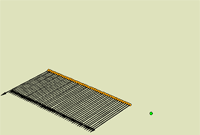INTAS-NETWORK Project No 03-514778
WORKSHOP 20004
"Hierarchy of scales in magnetic
nanostructures"
Summary
The aim of the project is to investigate the low-dimensional magnetism
at different spatial and temporal length scales, and to track the
evolution of fundamental magnetic interactions versus observation
scale and to develop routes for formation of artificial nanostructures
with unique magnetic properties.
We will study non-collinear spin structures in magnetically ordered
small supported clusters at the smallest obtainable length scale
and investigate strong correlations, responsible for the Kondo-like
resonance at low temperature.
At the next length scale, we will develop advanced technology of
multilayer growth with extremely low interface roughness. Various
complimentary experimental methods will be applied for the characterization
of samples, available to the teams participating in the project.
The interpretation of experimental data and the theoretical reconstruction
of atomic-scale interface structures will be performed by using
modeling of sample growth and subsequent self-consistent calculations
of magnetic moments on each atom using various ab-initio and real
space Hamiltonian approaches.
Growth of the multilayers with thin magnetic layers and very flat
interfaces will allow us to grow superlattices, where the transition
from three-dimensional (3D) to two-dimensional (2D) magnetism can
be experimentally realized. Such a transition will be achieved by
manipulation of the interlayer exchange coupling with hydrogen loading.
The dependence of the Curie temperature for the individual ferromagnetic
layers as a function of the sign and strength of the interlayer
exchange coupling will give unique information about phase transition
in 3D, 2D and intermediate dimensionality.
Ordered arrays of ferromagnetic nanoparticles and quantum dots
with different lateral size and with various distances between dots
will be fabricated on metal surface. The influence of interaction
between particles on their collective magnetic behaviour will be
studied using complimentary experimental methods. Exploring the
influence of the exchange coupling and finite size effects on magnetic
phase transitions will be performed in extended films and patterned
magnetic structures. Experiments will be complemented with calculations
of magnetic structure as well as micro-magnetic modeling.
The integration of the research activities of the group members,
which already exists between some of the group, will create a more
concerted approach to tackle the most challenging problems in low
dimensional magnetism by making a better and more cost-effective
use of resources.
Participants
- Uppsala University, Department of Physics, Uppsala, Sweden.
(Prof. Bjorgvin Hjorvarsson, co-ordinator)
- St.Petersburg State University, ICAPE, St.Petersburg, Russia.
(Prof. Valery Uzdin, co-ordinator from Russian side)
- Ruhr-University Bochum, Department of Physics and Astronomie,
Bochum, Germany.
(Prof. Hartmut Zabel)
- Russian Federal Nuclear Center - VNIIEF, Sarov, Russia
(Dr. Yurij Kudasov)
- CNRS, Institut Physique et Chimie des Materiaux, Strasbourg,
France.
(Dr. Claude Demangeat)
- Institute for Physics of Microstructures , Nizhnij Novgorod,
Russia
(Prof. Andrej Fraerman)
- University Duisburg-Essen, Duisburg, Germany.
(Prof. Werner Keune)
- Physical-Technical Institute of Ural Branch of Russian Academy
of Sciences, Udmurtian State University, Izhevsk, Russia.
(Prof. Anatoly Arzhnikov)
- University of Valladolid, Valladolid, Spain
(Prof. Andreas Vega)
- Joint Institute for Nuclear Research, Frank Laboratory of Neutron
Physics, Dubna, Moscow Region, Russia.
(Prof. Viktor Aksenov)
|

